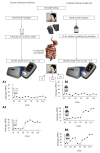Irritable bowel syndrome and small intestinal bacterial overgrowth: meaningful association or unnecessary hype
- PMID: 24627585
- PMCID: PMC3949258
- DOI: 10.3748/wjg.v20.i10.2482
Irritable bowel syndrome and small intestinal bacterial overgrowth: meaningful association or unnecessary hype
Abstract
Irritable bowel syndrome (IBS) is a common condition characterized by abdominal pain or discomfort, bloating, and altered stool form and passage. Small intestinal bacterial overgrowth (SIBO) is a condition in which there is overgrowth of bacteria in small bowel in excess of 10⁵ colony forming units per milliliter on culture of the upper gut aspirate. Frequency of SIBO varied from 4%-78% among patients with IBS and from 1%-40% among controls. Higher frequency in some studies might be due to fallacious criteria [post-lactulose breath-hydrogen rise 20 PPM above basal within 90 min (early-peak)]. Glucose hydrogen breath test (GHBT) has a low sensitivity to diagnose SIBO. Hence, studies based on GHBT might have under-estimated frequency of SIBO. Therefore, it is important to analyze these studies carefully to evaluate whether the reported association between IBS and SIBO is over or under-projected. This review evaluates studies on association between SIBO and IBS, discordance between different studies, their strength and weakness including methodological issues and evidence on therapeutic manipulation of gut flora on symptoms of IBS.
Keywords: Dysbiosis; Functional bowel disease; Glucose hydrogen breath test; Gut flora; Lactulose hydrogen breath test.
Figures



References
-
- Ballou SK, Keefer L. Multicultural considerations in the diagnosis and management of irritable bowel syndrome: a selective summary. Eur J Gastroenterol Hepatol. 2013;25:1127–1133. - PubMed
-
- Gonzales Gamarra RG, Ruiz Sánchez JG, León Jiménez F, Cubas Benavides F, Díaz Vélez C. [Prevalence of irritable bowel syndrome in the adult population of the city of Chiclayo in 2011] Rev Gastroenterol Peru. 2012;32:381–386. - PubMed
-
- Gwee KA, Lu CL, Ghoshal UC. Epidemiology of irritable bowel syndrome in Asia: something old, something new, something borrowed. J Gastroenterol Hepatol. 2009;24:1601–1607. - PubMed
-
- Krogsgaard LR, Engsbro AL, Bytzer P. The epidemiology of irritable bowel syndrome in Denmark. A population-based survey in adults ≤ 50 years of age. Scand J Gastroenterol. 2013;48:523–529. - PubMed
Publication types
MeSH terms
Substances
LinkOut - more resources
Full Text Sources
Other Literature Sources

